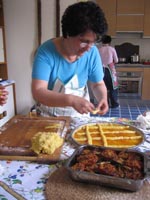 |
By Allyson Carroll |
 Agata Aguzzi laughs from behind a glass of her grandmother’s homemade cherry wine at hearing her father say he would do the dishes if he had to. She wants written proof of his claim. But in Italy, the roles of men and women are becoming less sharply defined. Despite these cultural adjustments, smaller towns such as Cagli still hold one tradition that has experienced little change: the pausa. Agata Aguzzi laughs from behind a glass of her grandmother’s homemade cherry wine at hearing her father say he would do the dishes if he had to. She wants written proof of his claim. But in Italy, the roles of men and women are becoming less sharply defined. Despite these cultural adjustments, smaller towns such as Cagli still hold one tradition that has experienced little change: the pausa.
|
Pausa is the three-hour period in the early afternoon during which businesses close and families congregate in the home for lunch, or pranzo, and to relax before returning to their daily work. In the past, the mother would prepare a three-course meal of pasta with bread, meat and fruit with coffee.
|
Today, whoever gets home first is the one who puts the water on to boil. Men are becoming familiar with what had been solely a woman’s terrain.
Though it may have experienced minor gender adjustments, the tradition of pausa is not something consciously thought about, but is rather a normal routine or way of life.
|
“Meeting with the family and being so united is part of the Catholic education that we have,” Mrs. Aguzzi. Not only is it almost bred into children since birth, but it is taught in school and church as part of their everyday education and religion.
While most men used to work close to home, many now hold jobs that require them to commute to other cities and towns. For many families, the three-hour pausa is getting more difficult to keep. For those working in factories, the tradition of pausa is fading fast. With only a 40-minute break for lunch, many factory workers are choosing to eat cafeteria lunches.
|
 The Aguzzi family, however, stresses the importance of upholding this tradition. Mr. Aguzzi, when required to travel 124 miles to Ascoli Piceno in the southern Marche one morning for work, made the trek back home that afternoon for the three-hour pausa. The Aguzzi family, however, stresses the importance of upholding this tradition. Mr. Aguzzi, when required to travel 124 miles to Ascoli Piceno in the southern Marche one morning for work, made the trek back home that afternoon for the three-hour pausa.
Distance is not a factor when the will to be with family is strong as it is with the Aguzzis and many traditional Cagliesi families.
|
“If we lived in a big city,” Mrs. Aguzzi says, “I don’t know if we still could have met at noon every day. But we would have tried to work it out because to me and to us children come first.”
The family stresses the importance of making an effort to remain close-knit regardless of the challenges of modern society.
Even though Americans might find an easy solution for lunch at a restaurant, a second important factor of pausa is the meaning of home. Italians take pride in the history of their houses and their central importance in unifying the family. “The house physically is very important to us,” Mr. Aguzzi said. “The house is the focal point of our family. Outside of these walls we don’t feel as comfortable as we do inside. We feel more confident with each other. Outside these walls, it’s always us, but we act differently.”
|
 It is no wonder either that the home is so crucial. The Aguzzi home has been in the family since the 1500s—when it used to be a wool factory. It is no wonder either that the home is so crucial. The Aguzzi home has been in the family since the 1500s—when it used to be a wool factory.
Inside the home, the living room, rather than being arranged around a television or entertainment center, is organized around the fireplace because, as the father explained, conversation and interaction are more important to them than television. When the father returns home for pausa with his son, whom he workswith, they want to enjoy time together as family and not as co-workers. A comfortable atmosphere, within the walls of their four-story house, enables this positive interaction to take place.
While the practice of pausa may be changing as Italians adjust to differing work and family circumstances, to people such as the Aguzzi family in Cagli, pausa and pranzo are more than just meal and relaxation. They represent a way of life, the centrality of home and family reaffirmed for a few hours each day.
|
| |
photos by Greg Cavaluzzo, video by Alyssa Porambo,web design by Jen McNamara
[HOME] |
|
 |
